
On 24th of July, 2005, Howard and I spent over 3 hours in the Orsay and the next day over 5 in the Louvre. I don't think that I have ever been in as busy a museum as the Louvre. By far the most common language we heard after French was Spanish...then probably Japanese. We took so many pictures at the two places that it will be hard to decide which ones to include. Photography without flash is allowed in both museums. Many people use flash, and there are not enough guards to stop them.
The Orsay is a fantastic art museum of French artists from the 18th century but the pieces are mainly from 1848 to 1914, mostly Impressionists. It starts where the Louvre stops. The museum formerly was a train station, and the conversion is amazing. It was the perfect place for such a museum.
We saw some very well-known pieces including Millet's The
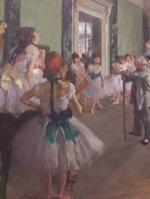
 Gleaners,Whistler's Mother (OK, it isn't French), many dance paintings by
Gleaners,Whistler's Mother (OK, it isn't French), many dance paintings by Degas, a number of paintings by Monet (though not as many as I had seen at a special exhibit ten years ago at the Chicago Art Museum), and Manet's pre-Impressionist best-known paintings, and works of post-Impressionists including VanGogh, Cezanne, Renior, Pointalism (which I had never seen before), and Primitives such as Rousseau, Toulouse-LaTrec, and finally sculptures such as Honore Balzac by Rodin and his Judgment Day.
Degas, a number of paintings by Monet (though not as many as I had seen at a special exhibit ten years ago at the Chicago Art Museum), and Manet's pre-Impressionist best-known paintings, and works of post-Impressionists including VanGogh, Cezanne, Renior, Pointalism (which I had never seen before), and Primitives such as Rousseau, Toulouse-LaTrec, and finally sculptures such as Honore Balzac by Rodin and his Judgment Day. 


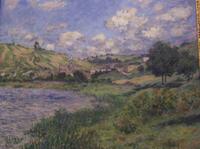
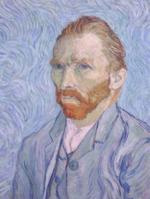


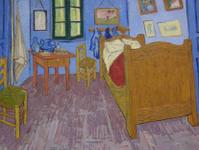
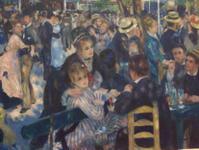

Except for the pastels which are under glass
 and in dark areas, the
and in dark areas, thepaintings and sculptures are out in the open. We are told not to touch, but one could easily reach them. Rick Steves' book was very helpful for us at the Orsay, esepecially since the Orsay map that was handed out was not as helpful in locating paintings as the Louvre one was that we got the next day. Steves' over 20 pages on the Orsay also gave good background history on the paintings.

When we walked back from the Orsay, we first we tried to find the Little Prince Bookstore in the Left Bank, almost Latin Quarter. We found it, but it was closed on Sunday, as were a lot of other places.
So, we walked back on the Islands and had dinner at a place Rick Steves recommended (Cafe Med) which had a decent meal for 12.5 euros. We stopped at the Deportation Museum (WWII) at the end of an island. Since it was drizzling most of the days, a lot of the bookstalls along the river were closed, but we did manage to find another Simenon police mystery for our friend Ron.


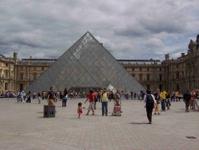
The next day, we headed out at 8:30 and took the metro (we had bought the ten-ticket special which we are sharing) to the Louvre. We entered from below, from the subway, and got in rather quickly. Before getting tickets, we walked by the inverted triangle, and both of us found it intriguing. I was prepared to really dislike Pei's triangles, but they were fascinating, and the new below-ground entrance to the Louvre is really functional and attractive. It actually was faster to stand in line at the staffed ticket booth than to use the automated machines. The Louvre free museum map is better than the one at the Orsay because it better shows where key pieces are located. The museum is immense.

We did go to more than Steves' recommended and thoroughly enjoyed it...except for the sore feet we had at the end for standing or walking so slowly. We headed up to the Mona Lisa (called by most La Gioconda), the famous painting of Lisa del Giocondo, to get there before the crowds. It has been under glass since it was damaged in recent years by someone who tried to attack it, and there is a semi-circular cord/metal barrier keeping people away from closer access to the painting. Therefore, it was hard to get a decent picture. The smile is even more enchanting than I had imagined it.
We then passed through the rooms with large-format French paintings. Howard was most impressed by the huge David's, including the Coronation of Napoleon , the Rape of the Sabine Women, and the Oath of the Horatii.
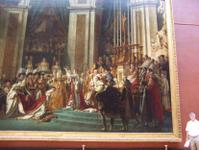
 The Death of Socrates was not there, but Howard saw it in the MET. Howard explained that David (the favorite painter of Napoleon) clearly showed that in the Coronation painting, although the Pope had come to crown Napoleon, Napoleon took the crown from the Pope and put it on his head himself. (We think the pope is seated on the right, in the close-up shot I
The Death of Socrates was not there, but Howard saw it in the MET. Howard explained that David (the favorite painter of Napoleon) clearly showed that in the Coronation painting, although the Pope had come to crown Napoleon, Napoleon took the crown from the Pope and put it on his head himself. (We think the pope is seated on the right, in the close-up shot I  took. Also, Howard said that David painted in Napoleon's mother in the top
took. Also, Howard said that David painted in Napoleon's mother in the top  left quarter of the picture, even though she had not been present. The larger, off-kilter picture of the coronation with Howard in the lower righthand corner shows how huge the paintings are.
left quarter of the picture, even though she had not been present. The larger, off-kilter picture of the coronation with Howard in the lower righthand corner shows how huge the paintings are.We then headed down a floor to go through ancient art, starting with Mesopotamia and the Code of Hammurabi. The code was created over 3800 years ago in ancient Mesopotamia and is one of the earliest sets of laws found. The laws (numbered f
 rom 1 to 282, but numbers 13, 66–99, 110, and 111 are
rom 1 to 282, but numbers 13, 66–99, 110, and 111 are  missing) are inscribed in Old Babylonianon on an 8 foot tall stela of black diorite. It was discovered in December 1901 in Susan in what is now Khuzistan, where it had been taken as plunder by the Elamites in the 12th century BC. The code is probably the first example of the legal concept that some laws are so basic so that even a king cannot change them. By writing the laws on stone, they were immutable. This concept lives on in most modern legal systems and has given rise to the term "written in stone" (paraphrased from Wikipedia).
missing) are inscribed in Old Babylonianon on an 8 foot tall stela of black diorite. It was discovered in December 1901 in Susan in what is now Khuzistan, where it had been taken as plunder by the Elamites in the 12th century BC. The code is probably the first example of the legal concept that some laws are so basic so that even a king cannot change them. By writing the laws on stone, they were immutable. This concept lives on in most modern legal systems and has given rise to the term "written in stone" (paraphrased from Wikipedia).
That whole area of the Louvre was amazing. We saw several fragments from the Stela of the Vultures stone pillar, probably the oldest pictorial depiction of an historical event which took place over 4450 years ago in Lagash, 100 miles north of Modern Basra, Iraq. It was written in cuneiform, the words first written language, invented by the Sumerians.
We also saw the first "copy machines," small
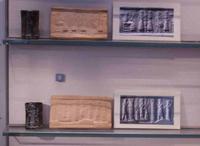 carved stone Sumarian cylinders. The huge statues from
carved stone Sumarian cylinders. The huge statues from 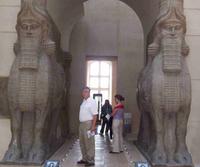 Akkad were unbelievable, including the Winged Bulls that graced the entrance of the palace of Sargon II. Many colored brick walls were
Akkad were unbelievable, including the Winged Bulls that graced the entrance of the palace of Sargon II. Many colored brick walls were  displayed from the
displayed from the 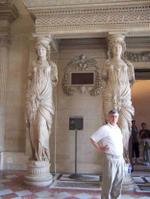 palace of Darius of
palace of Darius of  Persia, as were other amaazing Persian columns. There were a number of sarcophagu, including one of a Ramses and one sarcophagus
Persia, as were other amaazing Persian columns. There were a number of sarcophagu, including one of a Ramses and one sarcophagus  which was placed inside another which was placed inside
which was placed inside another which was placed inside 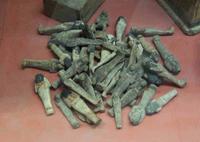 another. Next to it were tiny clay or wood "servants" to follow their owner to the next world. We saw many many sarcophagii including an intriguing one of a married couple. We enoyed this area greatly, and it had a lot fewer tourists.
another. Next to it were tiny clay or wood "servants" to follow their owner to the next world. We saw many many sarcophagii including an intriguing one of a married couple. We enoyed this area greatly, and it had a lot fewer tourists.The other very famous
 art work we saw was the Venus de Milo, which was surrounded
art work we saw was the Venus de Milo, which was surrounded  in layers by tourists. I found her more interesting from the rear than the front. Another amazing statue on a staircase center was Winged Victory of Samothrace.
in layers by tourists. I found her more interesting from the rear than the front. Another amazing statue on a staircase center was Winged Victory of Samothrace.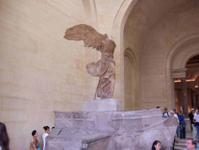
We saw some really good portraits like Holbein's portraits of Arasmus and Ann of Cleves (the one he did for Henry VIII...but he fell in love with her and painted her looking a lot nicer than she was, which really irked Henry VIII...who divorced her before consumating the marriage...and she became the painter's lover). Henry VIII did provide well for her, according to Howard. When we saw the picture, I wondered why such a plain person was painted for the King and was told that this was a much more flattering portrait than her actual appearance! We also saw the
 painting of (King) John the Good,
painting of (King) John the Good, 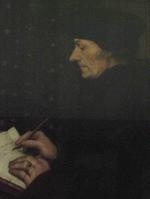 which is supposedly the first European
which is supposedly the first European  portrait just done as a portrait and not part of a religious work. It is done on wood in the 1350s and is under glass as it probably is not in great condition. Very few pictures except pastels were not within reach of viewers. It really amazed us.
portrait just done as a portrait and not part of a religious work. It is done on wood in the 1350s and is under glass as it probably is not in great condition. Very few pictures except pastels were not within reach of viewers. It really amazed us.Finally, we went through the galleries explaining the history of the Louvre and also showing the underground medieval parts left of the Louvre. It was
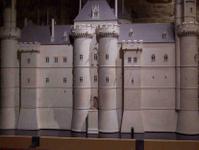 stunning. A chapel from that time really gave a clear idea of how the
stunning. A chapel from that time really gave a clear idea of how the Louvre looked when first built in the thirteenth century. The explanations also showed plot maps of the Louvre from the 1300s when first built through the reconstructions of Louis Napoleon finished in 1870 when the total rectangle was finished (and then then new end destroyed by fire the next year).
Louvre looked when first built in the thirteenth century. The explanations also showed plot maps of the Louvre from the 1300s when first built through the reconstructions of Louis Napoleon finished in 1870 when the total rectangle was finished (and then then new end destroyed by fire the next year).After 5 hours, we were exhausted. We walked through part of the Tulleries, huge gardens
 (mostly grass with trees trimmed back to allow people to walk
(mostly grass with trees trimmed back to allow people to walk  under them but to still give shade) where people could sit, talk and play. We actually saw a machine trimming the trees. The Tulleries were much more of a "people" park and less than "gardens" than I had expected. It was extremely windy with dark, blustery forboding sky. We saw the Arche d'Triompe from a distance as well as
under them but to still give shade) where people could sit, talk and play. We actually saw a machine trimming the trees. The Tulleries were much more of a "people" park and less than "gardens" than I had expected. It was extremely windy with dark, blustery forboding sky. We saw the Arche d'Triompe from a distance as well as  the Eiffel Tower. After taking the Metro back, I fell into a drugged
the Eiffel Tower. After taking the Metro back, I fell into a drugged 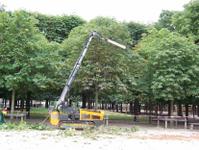 sleep for 3 hours.
sleep for 3 hours. 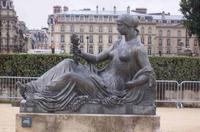
We headed out again at 8:30, walked through part of the Jewish quarter and saw at least 8 Kosher fallafel shops as well as a religious bookstore we will return to tomorrow to get a friend a French haggadah, and then headed back to the islands, where we watched games like bocci on the pseudo beaches along the river and sat for an
 hour in the cold until the lights of Notre
hour in the cold until the lights of Notre  Dame were turned
Dame were turned  on...quite a spectacular site. The bridges too were quite pretty lit up at night.
on...quite a spectacular site. The bridges too were quite pretty lit up at night.I've included many more pictures than our original e-mail. We managed to get pretty good pics with available light--it was
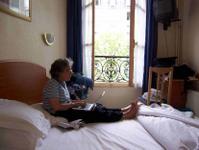 permitted to take pics without flash. The last pic is my classic pose at th
permitted to take pics without flash. The last pic is my classic pose at th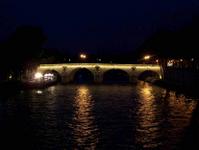 e one place in our Paris hotel room where we could piggyback on someone else's wireless internet access. You can see how wide (narrow?) the room was....but it was perfectly fine for us and in a fantastic location.
e one place in our Paris hotel room where we could piggyback on someone else's wireless internet access. You can see how wide (narrow?) the room was....but it was perfectly fine for us and in a fantastic location.Dina and Howard

No comments:
Post a Comment